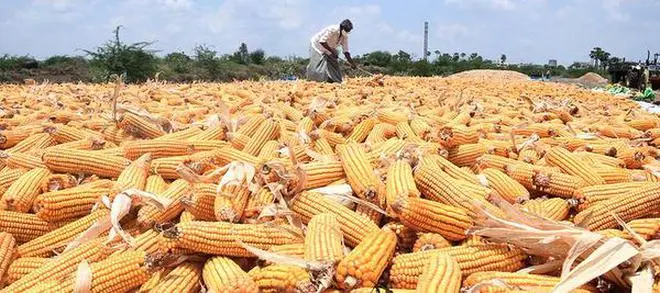Two global agencies have upgraded their outlook for Indian rice and maize production, easing concerns over food inflation in the country. The March Market Monitor report of the UN Food and Agricultural Organisation (FAO)’s Agricultural Market Information System and the World Agricultural Production report of the US Department of Agriculture (USDA) have made the upgrades based on the “favourable” prospects for the current rabi crops.
The Market Monitor has said India’s wheat production is “under favourable conditions”, while the USDA expects higher production of the cereal.
Easing worries

The outlook should ease concerns in the global market over Indian rice production, which was affected in the kharif season due to deficient rainfall in key growing regions of West Bengal, Bihar, Jharkhand, Odisha and eastern Uttar Pradesh.
According to the Ministry of Agriculture, India’s rice production has been estimated at a record 130.84 million tonnes (mt) despite the kharif output dropping over two mt to 108.07 mt this crop year (July 2022-June 2022) from 111 mt last crop year.
The USDA pegged India’s rice production at 132 mt for the marketing year (September 2022-August 2023), up two per cent from last year. Agricultural Market Information System (AMIS) said it has raised rice production by 6.4 mt.
Rabi sowing up 25%
The USDA said the harvested area is estimated at a record 47.0 million hectares (mh), up 2 per cent from last year. “Yield is expected to reach 4.21 tonnes per hectare up slightly from 2021,” it said.
In particular, the agency said rabi rice planting, which accounts for 30 per cent of total production, increased by 25 per cent, offsetting losses that occurred during the kharif season.
The rabi paddy crop benefited from ideal growing conditions and increased area. “Most of the rabi area increase was in Telangana (up 125 per cent) and West Bengal (up 32 per cent),” it said.
IMD forecast
AMIS report said transplanting of the rabi crop in India was almost complete with an increase in total sown area compared to last year.
The USDA said Indian farmers planted on time in October with good soil moisture and had adequate fertilizer. “Most of this crop is irrigated. Reservoirs as of the end of February were at least 80 per cent of capacity,” it said.
Low production of wheat last year due to a heatwave in March-April, dwindling central pool stocks with the Food Corporation of India and above-normal temperatures across the country in February had triggered fears over rabi crop production.
However, the India Meteorological Department (IMD), in its outlook for March, said barring a couple of districts in Gujarat, the temperatures in the rest of the country will not be of concern.
Wheat futures dip
The USDA has estimated maize (corn) production at a record high of 34.6 mt at par with the Ministry of Agriculture’s projections. “The harvested area is estimated at a record 10.1 mh, up 1 per cent from last year due to higher prices. Yield is estimated at a record 3.43 tonnes per hectare, up 1 per cent from last year,” it said.
The maize crop progressed under ideal growing conditions, it said. AMIS Market Monitor said conditions are favourable for the Rabi crop.
The Market Monitor said wheat futures continued to be affected by low-priced Russian wheat offers in the latest tenders of Northern African importers, indicating that the Russian Federation has ample supplies to deliver in the near future.
On other hand, maize prices were rangebound, with adverse weather conditions in South America supportive of higher prices. But USDA’s forecast of record large yield and production estimate in US maize dragged the futures market in Chicago.
According to the International Grains Council, wheat prices are currently lower by over 30 per cent year-on-year and maize prices by over 11 per cent. Rice prices are, however, higher between 9 per cent (Vietnam) and 22 per cent (India).








Comments
Comments have to be in English, and in full sentences. They cannot be abusive or personal. Please abide by our community guidelines for posting your comments.
We have migrated to a new commenting platform. If you are already a registered user of TheHindu Businessline and logged in, you may continue to engage with our articles. If you do not have an account please register and login to post comments. Users can access their older comments by logging into their accounts on Vuukle.